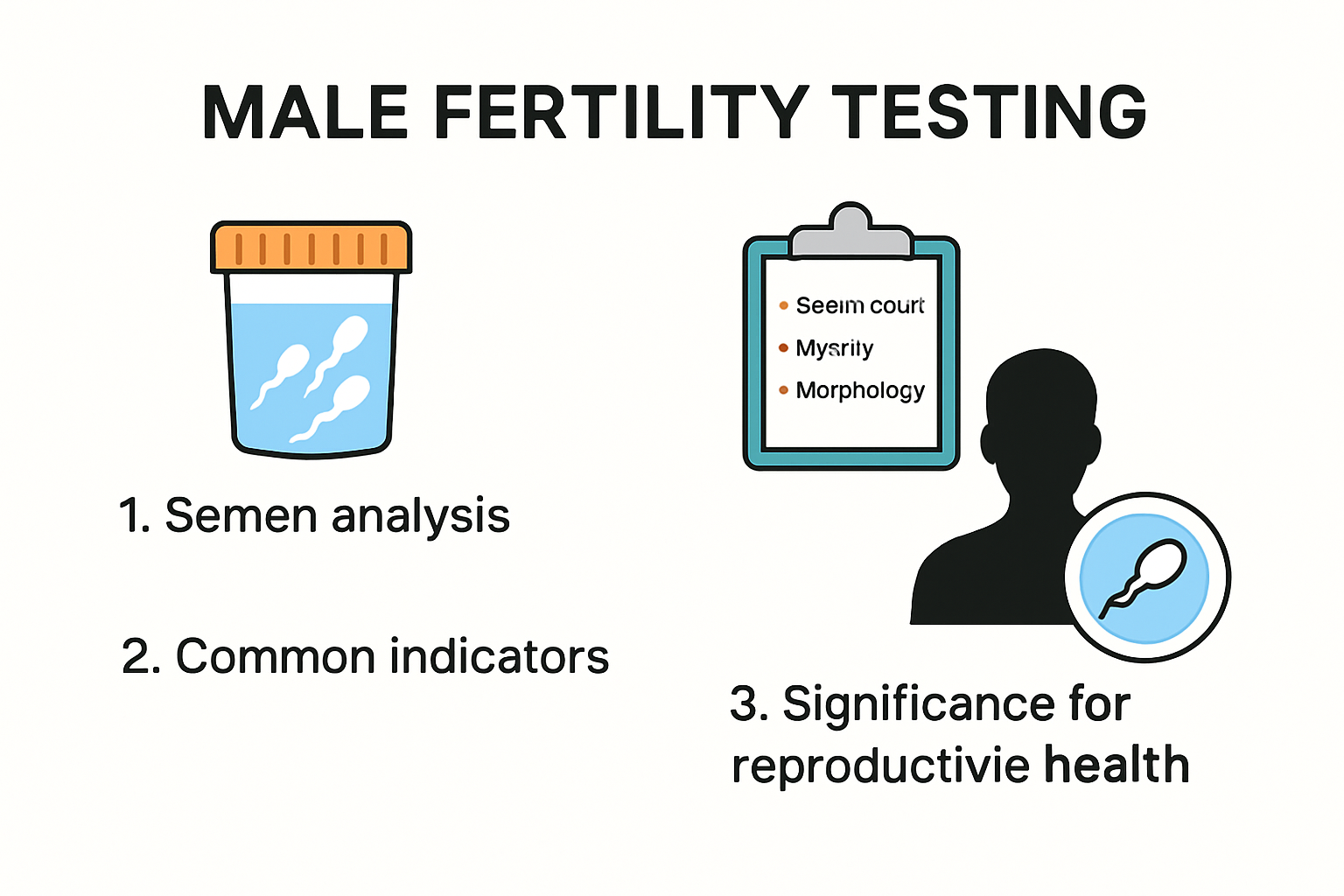Male fertility testing is not just a technical checklist. It is a gateway to understanding real reproductive health. Male factors play a role in about 40 to 50 percent of all infertility cases, yet most men do not get evaluated until months or years into the process. Few expect that something as simple as a semen sample could reveal so much. Here’s why a closer look now can change everything you thought you knew about fertility and planning for the future.
Table of Contents
- Understanding Male Fertility Testing Basics
- Testing After Vasectomy: What To Expect
- Male Fertility Testing For Couples Trying To Conceive
- Choosing The Right Male Fertility Test Option
Quick Summary
| Takeaway | Explanation |
|---|---|
| Semen Analysis is Crucial | It evaluates sperm concentration, motility, and morphology, which are essential for assessing male fertility and reproductive health. |
| Post-Vasectomy Testing is Essential | Conduct post-vasectomy semen analysis (PVSA) 8 to 16 weeks after the procedure to confirm the absence of motile sperm and ensure surgical success. |
| Holistic Approach to Fertility | Male fertility testing should include both partners for comprehensive evaluation, ensuring that potential reproductive barriers are addressed collaboratively. |
| Home Testing Kits Offer Convenience | Modern home testing kits provide a discreet and accessible way for initial fertility assessments, but professional evaluation is still necessary for accurate diagnosis. |
| Advanced Diagnostic Techniques Available | For deeper insights, consider hormonal evaluations and genetic testing to understand underlying factors that may affect fertility. |
Understanding Male Fertility Testing Basics
Male fertility testing is a critical diagnostic process that provides crucial insights into reproductive health and potential challenges. Male fertility testing evaluates multiple aspects of sperm production, quality, and potential barriers to conception or successful reproductive outcomes.

The Science Behind Sperm Analysis
At the core of male fertility assessment is the semen analysis, a comprehensive examination that goes far beyond simple sperm counting. Research from the American Urological Association reveals that this test evaluates three primary parameters: sperm concentration, motility, and morphology.

Sperm concentration measures the number of sperm per milliliter of semen. Motility assesses the sperm’s ability to move effectively, which is crucial for successful fertilization. Morphology examines the physical structure and shape of sperm, identifying potential genetic or developmental abnormalities that might impede fertility.
Diagnostic Insights and Medical Significance
According to the National Institute of Child Health and Human Development, male factors contribute to approximately 40% of infertility cases. This statistic underscores the importance of comprehensive male fertility testing. A thorough evaluation typically includes a detailed medical history, physical examination, and advanced semen analysis.
Medical professionals look for specific indicators during fertility testing. These include assessing sperm count, checking for genetic abnormalities, evaluating hormonal balance, and screening for potential underlying health conditions that might impact reproductive capabilities.
Post-Vasectomy Confirmation
Post-vasectomy semen analysis (PVSA) represents a specialized form of male fertility testing. Urological research emphasizes that this test is critical in confirming the success of a vasectomy procedure. Even after the surgical intervention, residual sperm can persist for weeks, making follow-up testing essential to ensure complete sterility.
The process involves collecting and analyzing a semen sample to verify the absence of sperm, which definitively confirms the vasectomy’s effectiveness. This step provides peace of mind and prevents potential unintended pregnancies.
For those looking to dive deeper into the nuances of sperm evaluation, our comprehensive guide on sperm function tests offers additional insights into advanced diagnostic techniques.
Understanding male fertility testing is not just about numbers and medical terminology. It is about empowering individuals with knowledge about their reproductive health, identifying potential challenges early, and making informed decisions about family planning and personal wellness.
Testing After Vasectomy: What to Expect
A vasectomy represents a significant decision in reproductive health, and post-procedure testing is crucial to ensure its effectiveness. Post-vasectomy semen analysis (PVSA) provides the definitive confirmation of surgical success and male sterility.
Timing and Initial Testing Protocol
Research from the National Institutes of Health recommends conducting the first semen analysis between 8 to 16 weeks after the vasectomy procedure. This specific timeframe allows sufficient healing and ensures accurate sperm count evaluation. During this period, patients should follow specific guidelines to prepare for testing.
Initial testing involves collecting a semen sample and submitting it for comprehensive analysis. The goal is to confirm the complete absence of motile sperm, which indicates successful vasectomy. Patients should abstain from sexual activity for 2-3 days before sample collection to ensure optimal testing conditions.
To help clarify the recommended steps after a vasectomy, here is a process table summarizing the testing protocol timeline and actions:
| Step | Timing After Vasectomy | Action/Requirement |
|---|---|---|
| 1 | 8-16 weeks | Collect and submit semen sample for analysis |
| 2 | Before sample collection | Abstain from sexual activity for 2-3 days |
| 3 | Upon test results | If motile sperm absent: Vasectomy confirmed successful |
| 4 | If motile sperm present | Repeat testing every 4-6 weeks until clear (up to 6 months) |
| 5 | Beyond 6 months if positive | Consider repeat vasectomy or additional diagnostics |
Understanding Test Results and Follow-up
Urological research from the American Urological Association indicates that a single azoospermic (sperm-free) sample is typically sufficient to confirm vasectomy success. However, if motile sperm are detected, additional testing at 4-6 week intervals might be necessary, potentially extending up to six months post-procedure.
Persistent presence of motile sperm beyond six months could indicate vasectomy failure. In such cases, physicians might recommend a repeat vasectomy or further diagnostic procedures. This underscores the importance of comprehensive and consistent post-vasectomy testing.
Home Testing and Modern Convenience
Modern advancements have transformed post-vasectomy testing, making it more accessible and convenient. Our comprehensive guide to vasectomy recovery provides insights into the latest testing methodologies that allow men to complete semen analysis from the privacy of their homes.
At-home testing kits provide a discreet, reliable method for post-vasectomy confirmation. These kits typically include everything needed for sample collection and secure laboratory submission. Users can expect detailed instructions, a prepaid shipping label, and secure online result reporting.
Patients should remember that while home testing offers convenience, following medical guidelines and consulting with healthcare professionals remains paramount. Each testing kit and result should be viewed as part of a comprehensive reproductive health strategy.
Successful post-vasectomy testing not only confirms the procedure’s effectiveness but also provides peace of mind for individuals and couples planning their reproductive future. By understanding the testing process and following recommended protocols, men can confidently navigate this important phase of their reproductive health journey.
Male Fertility Testing for Couples Trying to Conceive
Fertility is a shared journey, and understanding male reproductive health plays a crucial role in successful conception. Male fertility testing provides comprehensive insights that can help couples navigate potential challenges and make informed reproductive decisions.
Understanding Male Contribution to Fertility
Research from the National Center for Biotechnology Information reveals that male factors contribute to approximately 50% of infertility cases. Specifically, male infertility is the sole cause in 20% of cases and a contributing factor in an additional 30%. This statistic underscores the importance of thorough male fertility evaluation.
A comprehensive assessment goes beyond simple sperm counting. Stanford Children’s Health explains that a detailed evaluation includes medical history, physical examination, and advanced semen analysis. This holistic approach helps identify potential reproductive challenges and guides appropriate interventions.
Diagnostic Approaches and Comprehensive Testing
The American Society for Reproductive Medicine recommends concurrent fertility evaluations for both partners. This collaborative approach ensures a comprehensive understanding of potential reproductive barriers.
Key diagnostic elements in male fertility testing include:
- Semen analysis assessing sperm volume, concentration, motility, and morphology
- Hormonal assessments to evaluate testosterone and reproductive hormone levels
- Genetic screenings to identify potential inherited conditions
- Physical examinations to detect structural abnormalities
To summarize the recommended elements of male fertility testing for couples trying to conceive, here is a table outlining the key diagnostic approaches and their purposes:
| Diagnostic Test/Approach | Purpose |
|---|---|
| Semen Analysis | Assess sperm volume, concentration, motility, morphology |
| Hormonal Assessments | Evaluate testosterone and reproductive hormone levels |
| Genetic Screenings | Identify inherited/genetic conditions |
| Physical Examination | Detect structural abnormalities |
| Evaluations for Both Partners | Collaborative understanding of reproductive barriers |
Advanced Testing and Treatment Options
For couples seeking deeper insights, our detailed guide on sperm function tests offers advanced diagnostic perspectives. Modern fertility testing extends beyond traditional methods, incorporating sophisticated techniques that provide nuanced reproductive health information.
Home testing kits have revolutionized the fertility assessment landscape, offering discrete, convenient options for initial screening. These tools empower couples by providing accessible first-step diagnostics without the immediate need for clinical intervention.
While testing can reveal challenges, it is equally important to approach fertility as a collaborative process. Open communication, mutual support, and professional guidance are essential. Each test result represents an opportunity to understand reproductive health more comprehensively and develop personalized strategies for conception.
Remember that fertility is complex and multifaceted. A single test or diagnosis does not define a couple’s reproductive potential. With advances in medical technology and a holistic approach to reproductive health, many couples successfully overcome initial challenges and achieve their family planning goals.
Choosing the Right Male Fertility Test Option
Selecting the appropriate male fertility testing method is a critical decision that requires careful consideration of individual needs, medical history, and specific reproductive goals. Male fertility testing offers multiple diagnostic approaches, each designed to provide unique insights into reproductive health.
Comprehensive Diagnostic Approaches
Research published in the National Center for Biotechnology Information highlights that male fertility evaluation is multifaceted. The primary investigation remains semen analysis, which comprehensively assesses sperm concentration, motility, and morphology. This foundational test provides critical baseline information about reproductive potential.
Beyond basic semen analysis, medical professionals recommend additional diagnostic techniques. Hormonal evaluations measuring follicle-stimulating hormone (FSH), luteinizing hormone (LH), and testosterone levels can reveal underlying endocrine disorders affecting fertility. These nuanced assessments help create a more complete picture of reproductive health.
Advanced Testing Techniques
Genetic research indicates that specialized genetic testing becomes crucial for certain populations. Techniques like karyotyping and Y chromosome microdeletion analysis are particularly recommended for men experiencing non-obstructive azoospermia. These advanced diagnostic tools can uncover potential genetic factors influencing fertility.
Key considerations when selecting fertility testing options include:
- Personal medical history
- Age and reproductive goals
- Previous fertility challenges
- Specific symptoms or concerns
- Recommended approach by healthcare professionals
Home Testing and Professional Evaluation
Modern reproductive health technology has revolutionized fertility testing. Our comprehensive guide to sperm function tests explores the evolving landscape of diagnostic options, bridging the gap between clinical evaluations and convenient home testing.
Home testing kits offer an initial, accessible screening method. These convenient options provide men with a discreet first step in understanding their reproductive health. However, they should not replace comprehensive medical evaluation. Professional interpretation remains essential for accurate diagnosis and potential treatment strategies.
When choosing a fertility test, consider factors such as accuracy, comprehensiveness, ease of use, and cost. Some individuals might benefit from a combination of home testing and clinical evaluation. The goal is not just to obtain results but to gain actionable insights that support reproductive health and family planning goals.
Remember that fertility is a complex, personal journey. No single test provides a definitive answer. Consultation with healthcare professionals, open communication with partners, and a holistic approach to reproductive health are key to navigating this important aspect of personal wellness.
Frequently Asked Questions
What is male fertility testing and why is it important?
Male fertility testing evaluates factors like sperm concentration, motility, and morphology. It’s crucial because male factors contribute to about 40 to 50 percent of infertility cases, and early testing helps identify potential issues.
How long after a vasectomy should I get a post-vasectomy semen analysis?
A post-vasectomy semen analysis should be conducted 8 to 16 weeks after the procedure to confirm the absence of motile sperm and ensure the success of the vasectomy.
What tests are included in a comprehensive male fertility evaluation?
A comprehensive male fertility evaluation includes semen analysis, hormonal assessments to check testosterone and other reproductive hormone levels, genetic screenings, and a physical examination to identify any structural abnormalities.
Can I use home testing kits for male fertility assessment?
Yes, home testing kits offer a convenient and discreet way for initial fertility assessments. However, it’s important to follow up with a healthcare professional for a thorough evaluation and interpretation of the results.
Recommended
- Semen Analysis and Fertility Planning: Insights for Vasectomy and Conc
- Why Test Semen Sample: Answers for Vasectomy & Fertility 2025
- Sperm Function Tests Guide: Fertility, Vasectomy, and Beyond
- Why Semen Testing Is Critical: Insights for Men and Clinics
- Fertility Test Kit Benefits: Accurate Results for Vasectomy & Concepti
- Sperm Vitality Testing: Essential Guide for Vasectomy and Fertility





